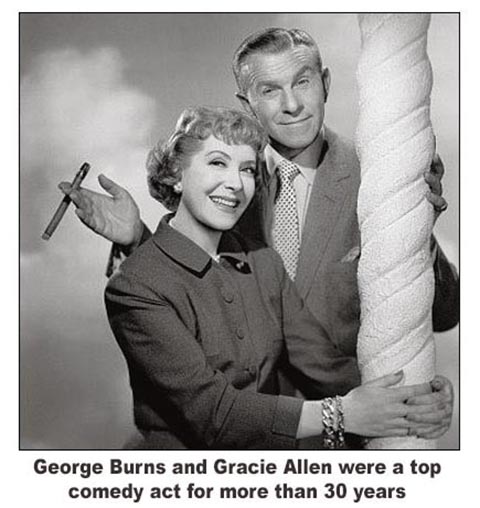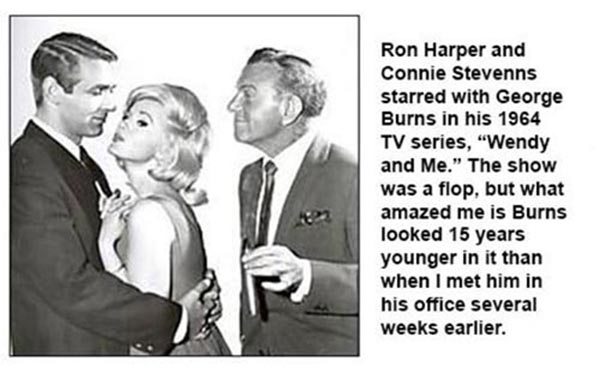August 9, 1964, Akron Beacon Journal
By JACK MAJOR
HOLLYWOOD – The name on the office door said George Burns, but the man inside looked more like J. Fred Muggs.
He sat low behind a desk that was several sizes too large ... and wore an old Ben Hogan-style golf cap that likewise was too large.
As expected, there was a big cigar in his mouth that blocked almost as much of his face a the cap. He removed the cigar only when he spoke – and then he used the cigar like a pointer, waving and thrusting it in all directions to emphasize his words. His chain-smoking had given the office an odor that would probably penetrate a gas mask.
His sportshirt and trousers were loud, even by California’s cartoon standards, but they obviously were comfortable.
He had on thick-rimmed glasses (the better to see through the cigar smoke, my dear) and the lines on his face make him look older than his 68 years.
But if George Burns is 68, he doesn’t know it. Nor does he act it.
He squeezed my interview between two very important meetings – one with the writers of his new television series, the other with a dance instructor who was helping Burns get in shape for his new nightclub act.
Burns seems every bit as busy as he was during his vaudeville and radio days with Gracie Allen, his wife and former partner.
“The way I look at it,” he said, “I’ve only been working since 1958. That’s when Gracie retired. When he were a team she did all the work. I’d start a routine by asking, ‘How’s your uncle?’ Then she’d talk for 17 minutes. It was great!”
Burns was preparing to make his annual summer trek to Las Vegas for a five-week nightclub engagement.
He has, since Gracie’s retirement, worked in nightclubs with a series of temporary partners, although these performers are never partners in the usual sense of the word.
He hires another act, then has special material written so that the two acts overlap in a team arrangement. He has worked this way with Ann-Margret, Carol Channing, Dorothy Provine and twice with Bobby Darin. This year he is teamed with the singing trio of Jane Russell, Beryl Davis and Connie Haines.
When he finishes in Las Vegas he will return to Hollywood to devote all his time – at least 12 hours a day – to not one, but two television shows.
“My company is filming ‘No Time For Sergeants,’ as well as my series, ‘Wendy and Me. I’ll supervise the writing on both shows.”
The ABC programs will run back-to-back on Monday nights from 8:30 to 9:30, starting in September.
Naturally Burns is excited about the programs, especially “Wendy and Me.”
“This is the one I should have waited for after Gracie retired,” he said.
Burns attempted one other show without Gracie, but it flopped. “And deservedly so,” he added, mashing a cigar into an ashtray and immediately lighting up another.
He doesn’t talk much about the new program because he believes it’s too early. “We’ll have to see the program on the screen before we know if it’s any good.”
When he does refer to the show the descriptive word he uses most often is “beautiful.” The situation is beautiful, his timeslot is beautiful, his leading lady (Connie Stevens) is beautiful ... even the boys are beautiful.
“We’ve got one young man, Ron Harper, who is so beautiful I’d like to dance with him myself. Except for me, this show should at least be pleasant to look at.”
Burns’ program is about an apartment house landlords who gets wrapped up in the affairs of his tenants. He’ll be most concerned with the Connie Stevens character, a housewife.
Most unusual feature of the program will be Burns’ use of a gimmick he employed on the old Burns and Allen TV show. He’ll step out of the situation from time to time and address remarks directly to the audience. Many of those remarks will be unrelated to the story.
For example, Burns intends to throw in somewhere a film clip of Jack Benny walking down a street. His explanation to home viewers: “I promised Jack I’d find a spot of him on my show. Well, here it is.”
Burns and Benny are close friends and tales of that friendship are legend. Burns can break up Benny with hardly any effort, while Benny has been frustrated in his efforts to do the same to Burns.
An often told story of one of Benny’s efforts is worth repeating. It happened a few years ago when Benny and Burns were appearing in the same city. Burns, as usual, had been driving Benny nuts with telephone calls and visits to his hotel room, and Benny was determined to catch Burns off guard.
One morning Benny heard a knock on his door and figured it was Burns. So Benny jumped up on his bed naked and stood there with a rose in his teeth and yelled for Burns to come in.
But it wasn’t Burns – it was a hotel maid.
“Jack laughs at almost anything I do,” said Burns, “just as long as I don’t tell him a joke. Jokes are his business. But if he comes into a room and I notice there’s a string on his suit, all I have to say is, ‘Jack, where can I get a string like that? I’d like to wear one on my suit, too.’ And he’ll fall down laughing.”
The conversation shifted back to Burns’ program and he explained why he selected Connie Stevens as his co-star.
“I think she’s a fine actress who can deliver the lines effectively. Notice I said an actress, not a comedienne. A comedienne wouldn’t work out on the show.
“Whenever Grace was sick in the old days, I got an actress like Jane Wyman or Claudette Colbert to replace her.
“You see, Gracie’s talent was as an actress, not as a comedienne. When she said her lines, she did in such a way that the audience believed Gracie was sincere about what she was saying.
“I’d ask Gracie why she put pepper in the salt shaker and salt in the pepper shaker and she’d say, ‘Why, silly, in case I get them mixed up.’
“Only an actress could make that funny. A comedienne’s approach would have made it too silly. After all, the joke IS silly, but if it’s said in such a way that the audience thinks the performer is serious, then it’s funny.
“Gracie had a way of expressing this kind of illogical logic as though she really believed it. I think Connie Stevens has the same quality.”
Burns began in show business when he was in his teens, but stumbled around without success for many years until he teamed with Gracie Allen in 1922.
“Before that I changed my act and my name at least once a year. I remember when I used the name Willie Delight. There really was another comedian named Willie Delight, and when he quit show business I took his calling cards, changed my name and used them.”
Burns and Allen were married in Cleveland in 1925. Originally Burns hired her to feed him the jokes, but he soon discovered she was getting the laughs, even with straight lines. Burns then switched roles and spent the next 36 years letting his wife take most of the bows.
It wasn’t until Gracie retired and Burns began accepting TV guest shots with Jack Paar and Benny that many people realized what a thoroughly funny guy Burns is. Even Burns wasn’t sure of himself.
“You know, Gracie wanted to retire five years before she did, but I wouldn’t let her. I felt it would be the end of me.”
Now Burns has firmly established a career without Gracie and will probably remain active in it for the rest of his life.
“I’ve no thought of retiring – or even slowing down. I thrive on work.”
Relaxation?
“I used to play golf, but gave it up after a game with Harpo Marx about 10 years ago. He parred the first two holes and birdied the third. Then he ran into trouble on the fourth.
“I didn’t want to annoy him, so I got as far away from him as possible and didn’t say a word. Apparently this got on his nerves because he came up to me after he took about 10 strokes on the hole and said, ‘George, you’re a nice guy most of the time, but you’re a son of a bitch on the golf course.’
“I haven’t played since.” |


